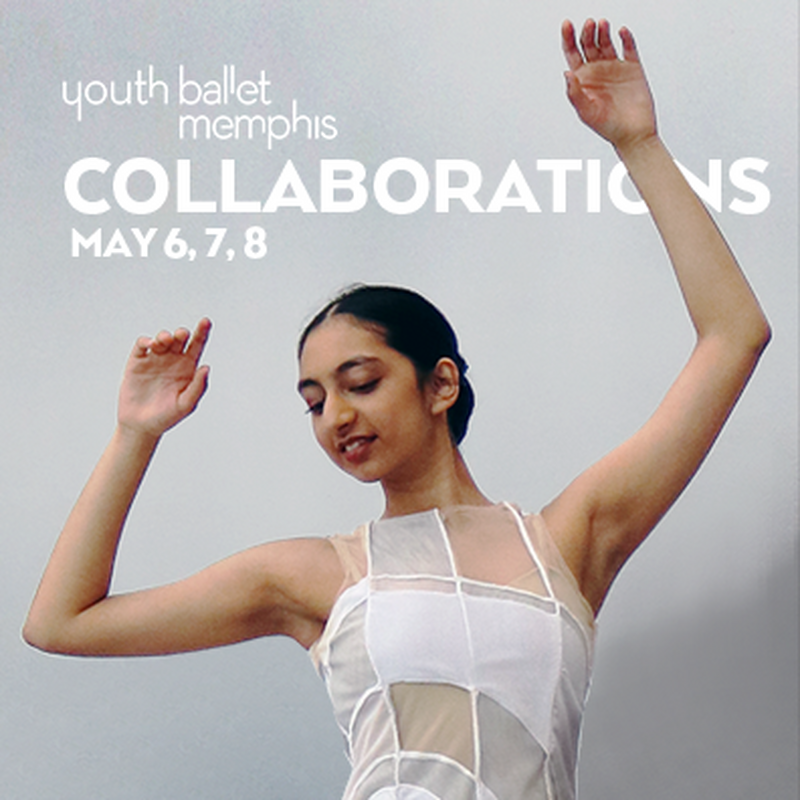YBM Collaborations: Choreographers Q&As
In preparation for Youth Ballet Memphis' Collaborations, we sat down with student choreographers Ayushi Gaur, Naisha Gaur, and Rosie Mullinax. To experience Collaborations, join us May 6-8th at Ballet Memphis Fly Studio.
Our Choreographer Q&As w/ Ayushi, Naisha, and Rosie:
What is the title of your piece? How did you decide on that name?
Naisha Gaur: Our piece is called Guilt’s Metronome. Our piece is inspired by the story of the Tell-Tale Heart by Edgar Allan Poe, so we wanted something to do with a heartbeat. In the story, the murderer is dealing with guilt and therefore hears the heartbeat of the old man he murdered. We liked the word “metronome” to symbolize the heartbeat but in a musical sense, and guilt’s metronome portrays how the guilt the murderer feels is like a metronome in his life, the metronome being the heartbeat of the dead man.
Ayushi Gaur: My piece is titled Melt. The piece is about human activity causing the melting of glaciers and sea ice in Arctic and Antarctic regions.
Rosie Mullinax: The title of our piece is Guilt's Metronome. We decided on that name because we were inspired by the short story The Tell-Tale Heart by Edgar Allen Poe, which involves a rhythmic heartbeat, similar to a metronome.
What was it like acting as a choreographer instead of a dancer?
NG: It felt weird at first to be directing people to do what I came up with instead of being the one to respond. I first didn’t feel confident about myself telling others what I wanted them to do, but as the rehearsals went on I felt I grew in my leadership skills and effectively created parts of our piece.
AG: I enjoyed the process of coming up with phrases of movement and seeing how the dancers in my piece made it feel like a completely different piece of movement. Of course, they did a great job of remembering and executing the steps I gave them, but I like to see how each dancer makes the movement their own.
RM: It was a nice change of pace and not difficult to transition from dancer to choreographer especially since we were choreographing onto fellow peers.
[The two other dancers and I] really pulled inspiration from each other and our vision of the piece as a whole.
Did you do anything specific to channel your inspiration?
NG: I like to improv to the music I am going to choreograph to, and then I keep the steps I like and put them together to create a phrase. I am definitely inspired by the piece of music I am working with, so I like to see what listening to the music makes me want to do, and that usually gets me to create movement I like.
AG: I am always thinking about climate change, so it just felt like a logical option to make my piece about it. I didn't do anything extra to channel my inspiration in that regard because rising sea levels due to melting glaciers is something that is always on my mind. In terms of dancing, I mostly got inspiration from the dancers in my piece. Not only in my rehearsals, but through watching them dance in other rehearsals, in class, and also just seeing them trying out random jumps and turns during breaks. It was inspiring to me to be able to give the dancers in my piece steps that would look bad if I did them, like high arabesques and penchés, and see how they are able to execute them in ways I never could.
RM: In this piece I worked with two other dancers, so we really pulled inspiration from each other and our vision of the piece as a whole to come up with specific choreography.
What did you learn from this experience? Is there anything you would do differently?
NG: I learned a lot about working in a group. Collaborating with people has both positives and negatives, as it is sometimes hard to agree when the three of us have different ideas of what we want, but it has taught me how to work effectively with others and to know when to take leadership but also when to follow the other person’s lead. We learned that if we split up sections to choreograph it went smoother than when we all tried to work on one section together. Something I would do differently is start going a little faster in the beginning of the process, since it felt like we had a lot of time at the beginning, but time moves quite quickly and we were stressed at the end to finish, so now I know to start working efficiently in the beginning to allow for more time to clean at the end.
RM: I learned from doing this that some dancers require a certain level of specificity when learning the choreography, which can sometimes slow the process of learning the dance. I would probably talk with the dancers in the beginning process next time to determine to what level of specificity is required for them to learn it best.




